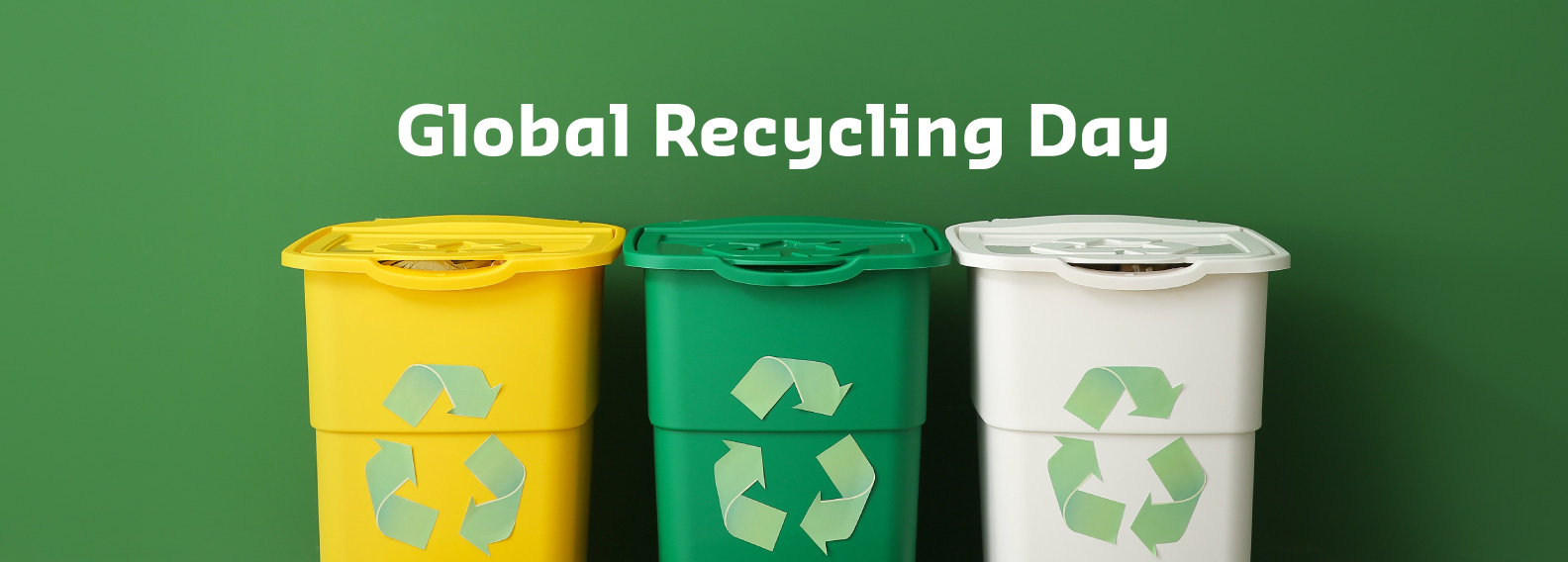On Global Recycling Day, Sodexo’s Head of Waste Management, Catherine Burrows, shares her thoughts on the important role recycling is playing in the journey to Net Zero.
For decades we have lived in a ‘take, make, throw’ economy. This has placed pressure on global natural resources for both extraction and end of life disposal, not forgetting the greenhouse gas emissions and pollution being created in the lifecycle.
 As businesses, we are currently setting Net Zero commitments and reviewing how we can operate sustainably, in order to keep below 2 degrees warming. Achieving these commitments requires a decarbonisation of the system and a creation of a circular economy; where materials are kept in use as long as possible, ensuring the value of the material is not lost. This could be through reuse, repair and leasing of products.
As businesses, we are currently setting Net Zero commitments and reviewing how we can operate sustainably, in order to keep below 2 degrees warming. Achieving these commitments requires a decarbonisation of the system and a creation of a circular economy; where materials are kept in use as long as possible, ensuring the value of the material is not lost. This could be through reuse, repair and leasing of products.
Recycling underpins the move towards a circular economy, though it focuses on the ‘end’ of an item’s current life. A circular economy looks to designing waste out of the system at the start – but to do this you need to understand your areas of waste generation.
The topic of recycling is complex and emotive. The media is both helping and hindering behaviours and perceptions. The system is complicated, especially when recycling systems vary between council areas making national campaigning and product labelling difficult.
This shouldn’t be an excuse for us to do nothing. Our role is to clear the waters and do what we can to enable and encourage our employees and service or product users to ‘do the right thing’.
The pandemic has seen a shift in the way we work, with many more people working from home. Understanding this change in how products and services may be delivered is a key priority. Businesses have adapted to Covid and now we must transition into embedding new behaviours in our new normal – we have a unique opportunity to re-evaluate, re-engage and reduce waste.
Sodexo’s journey
At Sodexo, we have committed to be Net Zero in our UK and Ireland operations by 2045 - to achieve this we will decarbonise our business by 90%, across all three carbon scopes (our direct and indirect emissions). More short-term targets include achieving a recycling rate of 70% by 2025.
As a facilities management and food services business, we have been working with our clients to increase recycling practices onsite, as their waste generation counts towards our scope 3 emissions. Alongside this, we are redesigning the way we function to remove waste from our operations, including eliminating single use plastics, further reducing our own and our clients’ emissions.
We work with many clients at different stages of their decarbonisation journey and understand different sectors have differing behaviours around recycling. A key learning is to understand the culture, priority and habits around recycling in each of their sectors and target the motivation, values and drivers of those individuals. Understanding these allows for targeted solutions to be delivered.
What can I do?
There are some key actions set out below that we can all take to increase recycling and minimise waste
Within our offices / workspaces:
- Review the journey of waste in the office, what are the common waste items? Where are they put? How does a user move around a building?
I recommend using a floor plan to plot this, assessing where and what waste occurs in the system.
- Use the journey to review the location of bins to improve segregation practice. For example, a food waste caddy next to the kettle, or a recycling bin next to a printer encourages users to correctly segregate at point of waste creation.
There are many great designs of recycling station available. We have used clear Perspex boxes attached to a recycling point, containing common items from a site to signpost where users should place the items. This creates the unconscious ‘nudge’ to encourage the correct behaviour. Visual signs showing common items also work as a positive and quick reference guide.
- Engage staff to encourage their feedback on how to reduce waste.
- Encourage use of reusable items such as cups and crockery to reduce single use items and waste volume.
- Set up food waste segregation and collections, to ensure it is sent for correct disposal.
- Review back of house waste collection schedules to ensure optimum supplier visit frequency – these may flex over time so adapt as needed. This will help to not only reduce carbon emissions from vehicles but collection costs too.
- Share recycling progress in newsletters or meetings to keep employees engaged
Business best practice:
- Get detailed waste data from your collection company and use this to set achievable targets on reducing waste volume and increasing recycling rates. Put together a communications plan (both internal and external) for sharing the targets and progressing towards goals.
- Develop training to support employees, encouraging knowledge sharing. Partnering or working with industry leading organisations – such as WRAP, WWF or Chartered Institute of Waste Management – can support this activity adding external authority and expertise to give your users confidence in the communications.
With increased staff working from home, add website links to policy or employee guidance. Empowerment is key for all of us. Signposting websites like Recycle Now and Love Food Hate Waste not only reinforces your commitment towards your own goals, but also promotes self-learning around sustainability.
- Review internal processes to ensure they support, rather than hinder, recycling or effective waste practice – a good example is washing out containers after use to ensure recycling passes correctly through the chain. In 19/20, over half a million tonnes of recycling was rejected along the recycling process due to contamination, costing Local Authorities over £48 million in additional costs.
As a product maker / service provider:
- Undertaking a waste audit of your end-to-end process of the product you create allows you to identify where waste occurs in the system. Working with supply chains and users explore the opportunities to reduce loss in the process or re-circulate materials during the products life.
- When you understand the loss areas, assess the materials being lost against the waste hierarchy to ensure items are being segregated and sent for best environmental impact processing. Engage your waste collection provider to help with this process.
- Where possible remove materials that aren’t required and work with mono materials e.g PET, Cardboard or those that can be easily separated to ensure materials can be re-cycled and re-circulated. Individuals often ‘wishcycle’ product, thinking they are helping but actually creating further problems downstream. A recent WRAP survey indicated 85% of us regularly recycle something that shouldn’t be recycled.
Review clear labelling on products around material type and end of life segregation (e.g on pack recycling labels) empowering users to do the right thing. Be conscious of the markets where your product will be used and the waste collection requirements of those areas.
Recycling is an activity we all do as individuals, a habit, part of the everyday. As businesses we need to enable, encourage and engage our staff and service users to do the right thing. The above steps are actions we can take to reduce complexity for our service users / staff.
References
1. https://ellenmacarthurfoundation.org/topics/circular-economy-introduction/overview
2. https://www.local.gov.uk/about/news/lga-over-half-million-tonnes-recycling-rejected-point-sorting#:~:text=Notes%20to%20editors-,525%2C000%20tonnes%20of%20household%20recycling%20collected%20was%20rejected%20at%20the,Authority%20Collected%20Waste%20Management%20stats.&text=It%20shows%20that%2036%20per,the%20time%20was%20non%2Drecyclable.
3. https://assets.publishing.service.gov.uk/government/uploads/system/uploads/attachment_data/file/69403/pb13530-waste-hierarchy-guidance.pdf
4. https://wrap.org.uk/resources/report/recycling-tracker-report-2021-behaviours-attitudes-and-awareness-around-recycling
